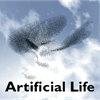Flow-Lenia: Emergent Evolutionary Dynamics in Mass Conservative Continuous Cellular Automata
IF 1.5
4区 计算机科学
Q4 COMPUTER SCIENCE, ARTIFICIAL INTELLIGENCE
引用次数: 0
Abstract
Central to the Artificial Life endeavor is the creation of artificial systems that spontaneously generate properties found in the living world, such as autopoiesis, self-replication, evolution, and open-endedness. Though numerous models and paradigms have been proposed, cellular automata (CA) have taken a very important place in the field, notably because they enable the study of phenomena like self-reproduction and autopoiesis. Continuous CA like Lenia have been shown to produce lifelike patterns reminiscent, from both aesthetic and ontological points of view, of biological organisms we call “creatures.” We propose Flow-Lenia, a mass conservative extension of Lenia. We present experiments demonstrating its effectiveness in generating spatially localized patterns with complex behaviors and show that the update rule parameters can be optimized to generate complex creatures showing behaviors of interest. Furthermore, we show that Flow-Lenia allows us to embed the parameters of the model, defining the properties of the emerging patterns, within its own dynamics, thus allowing for multispecies simulation. Using the evolutionary activity framework and other metrics, we shed light on the emergent evolutionary dynamics taking place in this system.Flow-Lenia:质量保守连续元胞自动机的涌现进化动力学。
人工生命努力的核心是创造人工系统,这些系统可以自发地产生在生命世界中发现的特性,如自创生、自我复制、进化和开放性。虽然已经提出了许多模型和范式,但元胞自动机(CA)在该领域占据了非常重要的地位,特别是因为它们能够研究自我繁殖和自创生等现象。从美学和本体论的角度来看,像Lenia这样的连续CA已经被证明可以产生逼真的图案,让人联想到我们称之为“生物”的生物有机体。我们提出Flow-Lenia,它是Lenia的一个大规模保守扩展。我们的实验证明了它在生成具有复杂行为的空间局部模式方面的有效性,并表明更新规则参数可以优化以生成具有感兴趣行为的复杂生物。此外,我们表明Flow-Lenia允许我们嵌入模型的参数,在其自身的动态中定义新兴模式的属性,从而允许多物种模拟。利用进化活动框架和其他指标,我们阐明了在这个系统中发生的紧急进化动态。
本文章由计算机程序翻译,如有差异,请以英文原文为准。
求助全文
约1分钟内获得全文
求助全文
来源期刊

Artificial Life
工程技术-计算机:理论方法
CiteScore
4.70
自引率
7.70%
发文量
38
审稿时长
>12 weeks
期刊介绍:
Artificial Life, launched in the fall of 1993, has become the unifying forum for the exchange of scientific information on the study of artificial systems that exhibit the behavioral characteristics of natural living systems, through the synthesis or simulation using computational (software), robotic (hardware), and/or physicochemical (wetware) means. Each issue features cutting-edge research on artificial life that advances the state-of-the-art of our knowledge about various aspects of living systems such as:
Artificial chemistry and the origins of life
Self-assembly, growth, and development
Self-replication and self-repair
Systems and synthetic biology
Perception, cognition, and behavior
Embodiment and enactivism
Collective behaviors of swarms
Evolutionary and ecological dynamics
Open-endedness and creativity
Social organization and cultural evolution
Societal and technological implications
Philosophy and aesthetics
Applications to biology, medicine, business, education, or entertainment.
 求助内容:
求助内容: 应助结果提醒方式:
应助结果提醒方式:


